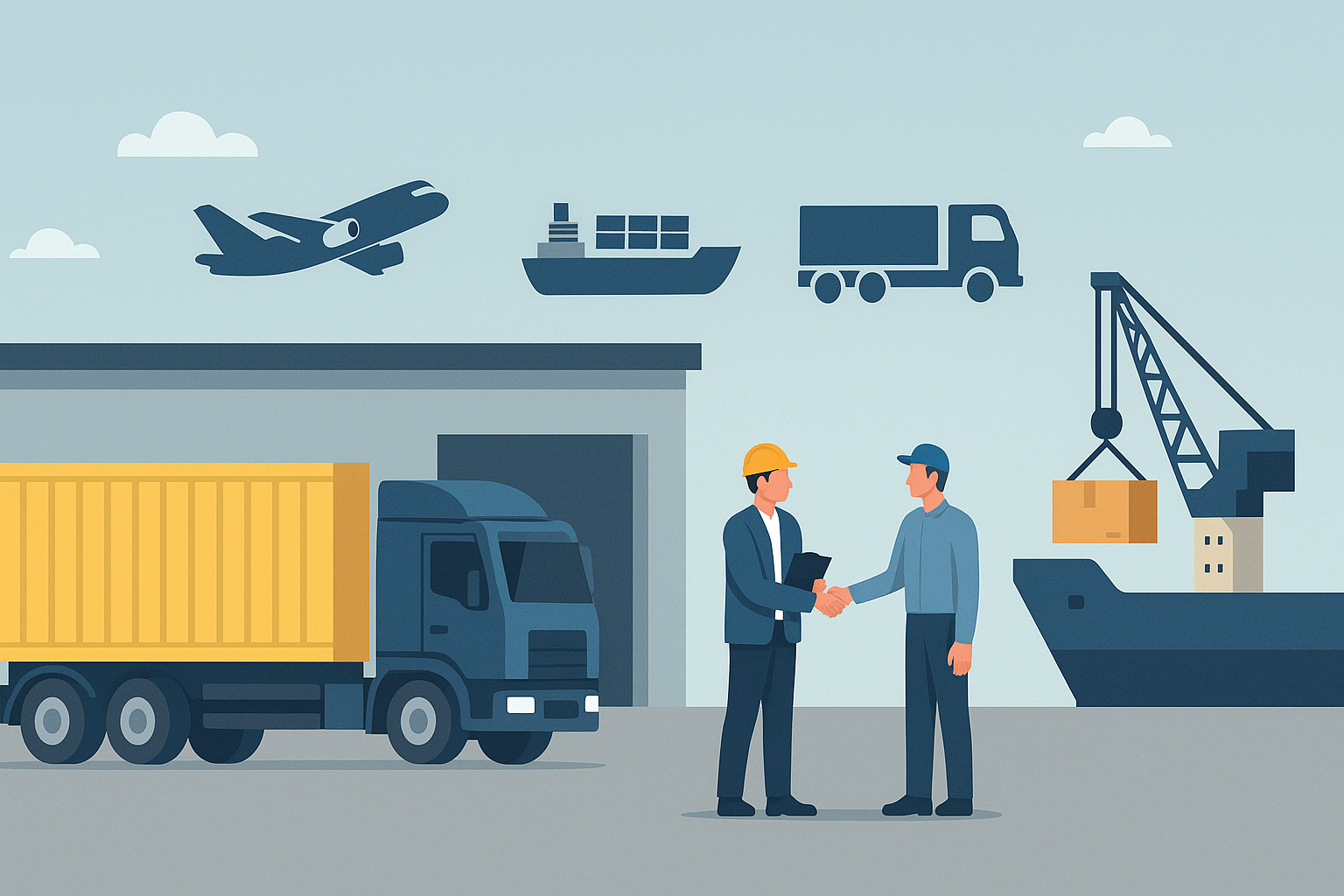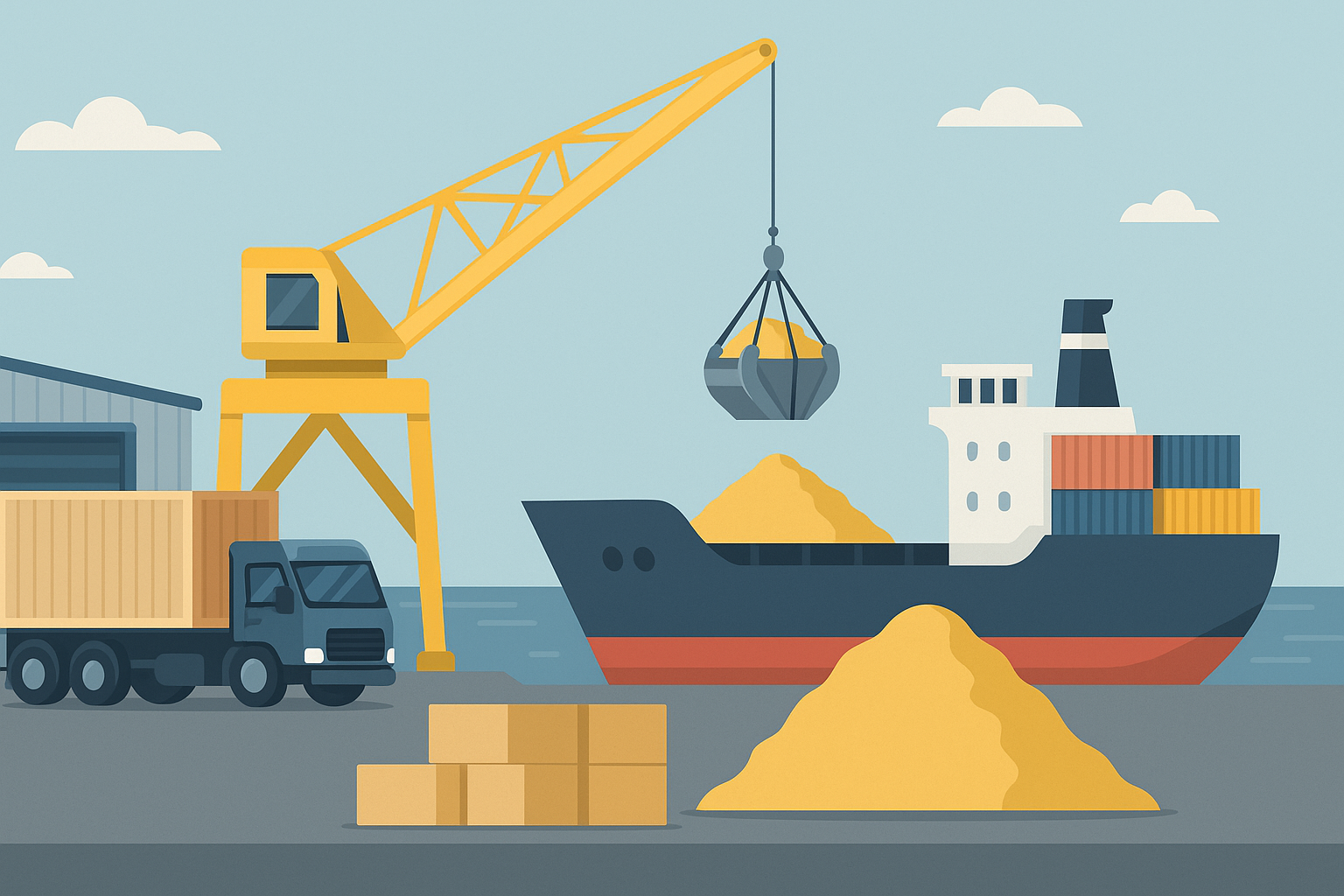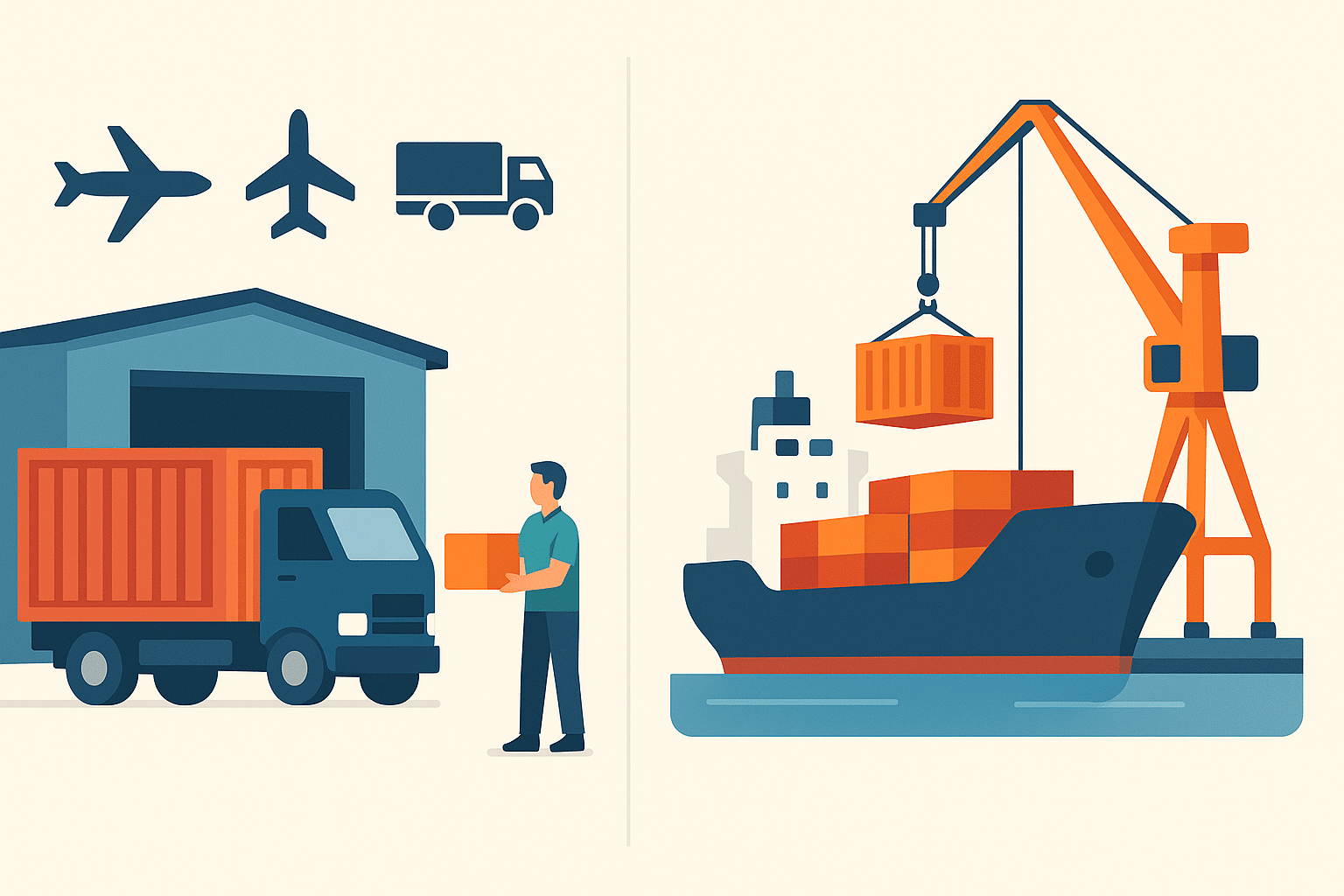When you’re dealing with international shipping, the terms in your contract decide more than just delivery dates. They set the line between what the seller handles and what you take on.
Two of the most common and most confusing are FCA vs. FOB. On paper, they look similar, but in practice, they shift costs, risks, and control in very different ways.
I’ve seen many businesses lose money simply because they picked the wrong one for their shipment. That’s why it pays to know exactly how they work.
Once you understand the differences, you can make better choices for your cargo and avoid disputes later. Let’s start by looking at what they mean.
FCA vs. FOB: A Simple Guide for Shippers
When you first start working with Incoterms, FCA and FOB can feel almost the same. Both explain when the seller’s job ends and when the buyer takes over. The main difference is in how goods are handed off and the type of transport allowed.
What is FCA (Free Carrier)?

FCA means Free Carrier. Under Incoterms 2020, it can be used with any type of transport: air, sea, road, or rail. That flexibility makes it one of the most practical choices, especially for containerized shipments.
FCA places clear responsibilities on both the seller and the buyer. Here’s a simple breakdown of who handles what, when risk changes hands, and how it plays out in practice:
| Aspect | Details |
|---|---|
| Seller Responsibilities | Prepares and packages goods, clears them for export, and delivers them to the buyer’s nominated carrier. Delivery may happen at the seller’s facility, a warehouse, or a port terminal. Once handed over, the seller’s role ends. |
| Buyer Responsibilities | Takes over after the goods are handed to their carrier. Pays for main transport, insurance, import customs clearance, and final delivery to the destination. |
| Risk and Cost Transfer | Shifts to the buyer the moment the goods are handed to the carrier at the agreed location. Any damage or loss after that point is the buyer’s responsibility. |
| Example Scenario | Electronics shipped from Shenzhen to New York. The seller clears export customs and delivers the container to the buyer’s freight forwarder at the port. From there, the buyer arranges ocean freight, insurance, and inland delivery. |
The key idea is that the seller’s job ends once the goods are with the buyer’s carrier. From that moment, the buyer manages the journey and carries the risk.
What is FOB (Free On Board)?

FOB stands for Free On Board. Unlike FCA, this rule applies only to ocean or inland waterway shipments. It’s best suited for bulk cargo that is loaded directly onto vessels.
With FOB, the seller’s job extends further, but risk still passes to the buyer once the goods are on the vessel. Here’s the breakdown:
| Aspect | Details |
|---|---|
| Seller Responsibilities | Prepares and packages goods, clears them for export, and loads them onto the vessel at the agreed port of shipment. Once the cargo is on board, the seller’s role is finished. |
| Buyer Responsibilities | Takes over after the goods are loaded onto the vessel. Pays for sea freight, insurance, unloading, import customs clearance, and final inland delivery. |
| Risk and Cost Transfer | Shifts to the buyer once the goods are physically loaded onto the ship. Any loss or damage after loading is the buyer’s responsibility. |
| Example Scenario | Grain exported from Buenos Aires to Spain. The seller loads the bulk grain onto the vessel at the port. Once it’s on board, the buyer covers the sea journey, insurance, and delivery after arrival. |
FOB works best for bulk or port-to-port ocean shipments where the seller can handle loading, but the buyer controls the voyage and beyond.
FOB vs. FCA: Key Differences
One of the biggest differences between FCA and FOB isn’t just about risk transfer; it’s about how the paperwork and control play out in practice.
With FCA, buyers usually need to work with their own carrier to secure the bill of lading.
That step can surprise people if they’re used to FOB, where the seller handles vessel loading and naturally provides the document. Without the bill, buyers may run into payment or customs delays.
Another difference lies in insurance and negotiation. Under FCA, buyers can negotiate directly with carriers and insurers from the start, often leading to better rates and coverage.FOB, on the other hand, gives sellers more control up to the loading stage, which can limit the buyer’s ability to manage costs early.
There are also common mistakes to watch for. Many businesses still use FOB for containerized cargo even though Incoterms recommend FCA. That choice can create disputes if something happens before the container is loaded on the vessel.
Takeaway: The fine print matters. FCA gives buyers more control and flexibility, but also more responsibility. FOB keeps things simple for sellers, yet it can leave buyers exposed if used in the wrong context
When to Use FCA vs. FOB
Choosing between FCA and FOB depends on shipment type, control, and responsibilities. Use these guidelines to make the right call:
| Situation | Best Choice | Why |
|---|---|---|
| Containerized or multimodal shipments | FCA | Works for all transport modes and gives buyers earlier control over freight and insurance. |
| Bulk or port-to-port ocean shipments | FOB | Suited for bulk cargo like grain or coal, where sellers already handle vessel loading. |
| Buyer preference | FCA | Buyers like FCA because it lets them control the main transport and manage costs more closely. |
| Seller preference | FOB | Sellers often choose FOB because their role ends once goods are loaded, making things simpler. |
FCA is the smarter choice for containerized and multimodal shipments, while FOB still makes sense for bulk cargo moved by sea. Picking the right term upfront keeps costs and responsibilities clear for both sides.
Mistakes to Avoid
When working with FCA or FOB, it’s easy to make small mistakes that lead to big costs. Here are the ones to watch out for:
- Using FOB for containerized goods: FOB is only meant for bulk ocean shipments. Using it for containers makes the seller responsible for extra port handling, which can cause delays and added costs.
- Not agreeing on the named place under FCA: FCA always requires a named place, like a warehouse or port terminal. If this isn’t clearly stated, disputes can happen over who pays for inland transport.
- Confusing risk transfer with cost responsibility: Risk and cost don’t always switch at the same time. One side may still cover certain charges even after the risk has technically moved.
- Forgetting about insurance coverage: Neither FCA nor FOB requires the seller to insure the goods. If the buyer doesn’t set this up in time, the shipment may travel uninsured.
Avoiding these common slip-ups keeps contracts clear, reduces disputes, and makes shipping smoother for both sides.
In short, FCA fits modern container trade and gives buyers more control, while FOB still works well for bulk ocean shipments. Knowing when to use each term prevents costly mistakes.
Cost and Risk: Who Pays What?
It’s one thing to know where risk shifts, it’s another to see how that translates into actual costs. The money side is where FCA and FOB feel very different in practice.
1. Cost Breakdown in FCA
With FCA, the buyer usually pays for the main transport sooner. This can be a benefit if the buyer has strong freight contracts or wants to pick cheaper carriers. But it also means the buyer must be ready to handle inland charges after the seller’s handoff. For example:
- The seller pays for packaging, export clearance, and delivery to the agreed carrier.
- The buyer pays from the pickup point forward, including port handling, ocean freight, and insurance.
This structure often reduces seller costs but gives the buyer more expenses upfront.
2. Cost Breakdown in FOB
Under FOB, the seller carries costs further since they must cover loading onto the vessel. That includes local port charges, terminal handling, and labor for loading. Once the cargo is on the ship, all new costs move to the buyer. For example:
- The seller pays until the goods are on board, including vessel loading fees.
- The buyer pays for sea freight, unloading, and inland delivery at the destination.
This setup can be easier for sellers, but sometimes raises their port-side costs.
3. Insurance Responsibilities
Insurance often gets overlooked, but it’s a key difference in practice.
- In FCA, the buyer arranges insurance earlier, since risk transfers at the carrier handoff.
- In FOB, the buyer takes on insurance only after goods are loaded on the vessel.
This timing can affect premiums: buyers using FCA may negotiate better coverage since they control the full main leg of transport.
4. Real Example Cost Breakdown
Picture two shipments of the same product, each valued at $50,000:
- FCA case: The seller pays about $500 in export fees and local trucking to deliver to the port. The buyer then pays $3,000 for sea freight, $800 for insurance, and $1,200 in destination charges.
- FOB case: The seller pays $1,200 for export fees, port handling, and vessel loading. The buyer pays $3,000 for sea freight, $600 for insurance (since coverage starts later), and $1,200 in destination charges.
The totals come out differently. FCA saves the seller money but gives the buyer more control and costs earlier, while FOB shifts more initial expense onto the seller.
The choice between FCA and FOB isn’t just about where risk transfers. It’s also about who pays what, when insurance kicks in, and how much leverage the buyer or seller has with carriers and ports.
FCA vs. FOB in Practice
It’s easier to see the real differences between FCA and FOB when you look at how they play out in actual shipments. Here are two simple case studies.
Case Study: Small Business Shipping Electronics (FCA)
A small U.S. retailer buys electronics from a supplier in Shenzhen. The deal is set up under FCA.
The seller clears the goods through Chinese customs and delivers the container to the buyer’s freight forwarder at the port. From that moment, the buyer manages ocean freight, insurance, and final delivery.
For the retailer, this works well. They already have a contract with a logistics company that gives them lower freight rates. They also want control of insurance and delivery schedules. FCA lets them keep costs predictable and flexible.
Case Study: Commodity Exporter Shipping Grain (FOB)
An Argentine exporter sells a bulk grain shipment to a European buyer. The contract is written under FOB.
The seller handles export clearance and pays for port labor to load the grain onto the vessel in Buenos Aires. Once the grain is on board, the buyer takes full control of freight, insurance, and import clearance.
For the exporter, this setup makes sense. Grain is loaded directly into the vessel’s hold, and the seller’s responsibility ends once that’s done. For the buyer, FOB is familiar and simple for bulk cargo — they take over only after the goods are safely loaded.
These examples show why FCA is often chosen for containerized goods and why FOB still dominates bulk cargo. Each term shifts not just responsibility but also the balance of control, cost, and convenience
Related Incoterm Comparisons
FCA and FOB are just two of the many Incoterms you’ll run into. Here’s how they compare to a few other common ones buyers and sellers often confuse them with:
1. FCA vs. CIF
CIF (Cost, Insurance, and Freight) places much more responsibility on the seller. With CIF, the seller pays for the cost of goods, insurance, and freight all the way to the buyer’s port. In contrast, FCA shifts control to the buyer much earlier, right after the goods are handed to their nominated carrier.
Buyers who want to manage freight and insurance themselves often prefer FCA, while CIF appeals to buyers who want sellers to handle everything until arrival.
2. FCA vs. DAP
DAP (Delivered at Place) means the seller delivers the goods to a named location in the buyer’s country, covering almost everything except import customs and duties. FCA ends much sooner, with the seller only responsible until the goods are handed to the buyer’s carrier.
DAP is buyer-friendly since it limits their role, while FCA works better when the buyer wants more control and flexibility over the main transport.
3. FOB vs. EXW
EXW (Ex Works) gives the seller the least responsibility. Under EXW, the buyer picks up the goods directly from the seller’s premises and handles everything else, loading, export, freight, and insurance. FOB, on the other hand, requires the seller to clear export customs and load the goods onto the vessel.
EXW favors sellers who want minimal involvement, while FOB gives buyers some protection since the seller ensures the goods get safely onto the ship.
These comparisons highlight the range of Incoterms, from seller-heavy ones like CIF and DAP to buyer-heavy ones like FCA and EXW. The right choice depends on how much control and responsibility each side wants in the deal.
Quick Decision Guide
Sometimes it helps to have a simple checklist. If you’re still unsure, here’s a quick way to decide between FCA and FOB:
Use FCA if…
- You’re shipping containerized goods.
- You want control over the main freight and insurance.
- You already have strong contracts with carriers or forwarders.
- You prefer flexibility with routes, costs, and timing.
Use FOB if…
- You’re shipping bulk cargo like grain, coal, or timber.
- The shipment is strictly port-to-port by vessel.
- You want the seller to handle export clearance and vessel loading.
- You prefer to take over only once the cargo is safely on board.
If your shipment involves containers or multiple modes of transport, FCA is usually the smarter choice. If it’s bulk cargo loaded directly on a vessel, FOB remains the easier option.
Conclusion
FCA vs. FOB may look similar at first, but once you see how costs, risk, and control shift, the choice becomes clearer. I’ve found that FCA works better for containerized trade, while FOB still has its place in bulk ocean shipping.
If you’re the one making the call, think about where you want responsibility to change hands and how much control you’d like over freight and insurance. That’s the main takeaway you can apply right away.
For more tips on Incoterms and global shipping, check out my other blogs; they’ll give you practical guidance to make your logistics decisions easier.















